Samsung Electronics Co SGHI900 Cellular/PCS GSM/EDGE Phone with Bluetooth User Manual SGH i900
Samsung Electronics Co Ltd Cellular/PCS GSM/EDGE Phone with Bluetooth SGH i900
Users Manual

9. User Manual

Some of the contents in this manual may differ from your device depending on the software of the device or
your service provider.
World Wide Web
http://www.samsungmobile.com
Printed in Korea
Code No.:GH68-XXXXXA
English (EU). 03/2008. Rev. 1.0
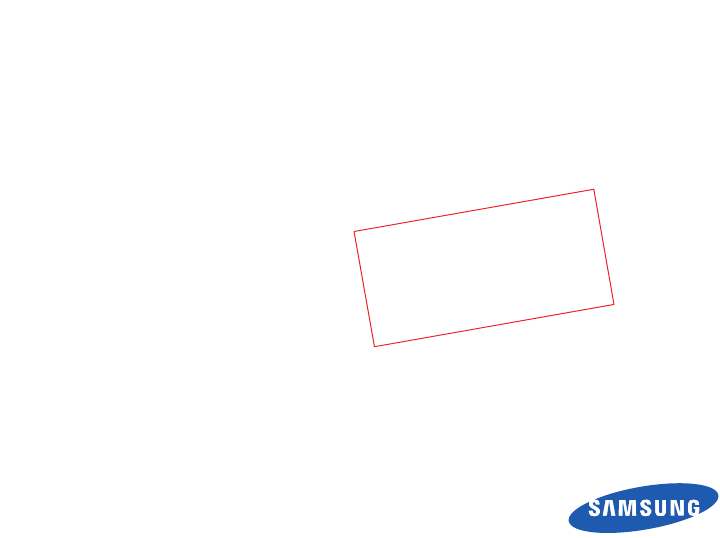
SGH-i900
user manual
Draft 01
2008. 02. 29
SW version:PDA i900XXHA1
Phone i900XXHA2
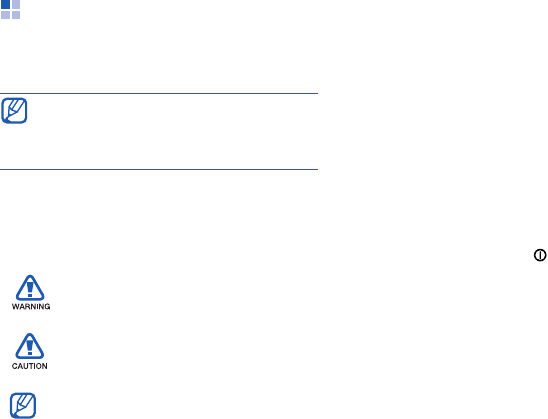
Using this guide
This user’s guide has been specially
designed to guide you through the functions
and features of your device.
Instructional icons
Before you start, familiarise yourself with
the icons you will see in this guide:
For any topics not covered in this guide,
please refer to the Help embedded in the
Windows Mobile
®
6 Professional operating
system.
Warning—situations that could
cause injury to yourself or others
Caution—situations that could
cause damage to your device or
other equipment
Note—notes, usage tips, or
additional information
X
Refer to—pages with related
information; for example:
X
p. 12 (represents "see page
12")
→
Followed by—the order of options
or menus you must select to
perform a step; for example: Tap
Start
→
Programs
→
Camera
(represents
Start
, followed by
Programs
, followed by
Camera
)
[ ] Square brackets—device keys;
for example: [ ] (represents the
Power key)

Copyrights and trademarks
Rights to all technologies and products that
comprise this device are the property of
their respective owners:
• This product includes
software licensed from
MS, an affiliate of the
Microsoft Corporation.
Microsoft and software bearing the
Microsoft name are registered trademarks
of the Microsoft Corporation. Before using
this product, refer to the MICROSOFT
SOFTWARE LICENSE TERMS FOR
WINDOWS MOBILE 6 SOFTWARE
Agreement at the back of this guide for
information about rights and restrictions.
• Java™ is a trademark of
Sun Microsystems, Inc.
• Bluetooth
®
is a registered trademark of
the Bluetooth SIG, Inc.
worldwide—Bluetooth QD ID: B0XXXXX
2
Contents
Safety and usage information ............. 4
1. Enter text 10
Change the text input method ...........10
Change the default text input method .10
Enter text with the onscreen keyboard 10
Enter text with Letter Recognizer .......11
Enter text with Block Recognizer ........11
Enter text with Transcriber ................12
Create a sketch ................................13
2. Communication 14
Calls ...............................................14
Messaging .......................................15
3. Media 18
Camera ..........................................18
Media Album ...................................20
Photo Slides .................................... 22
Touch Player ................................... 23
FM Radio ........................................ 24
4. Personal productivity 26
Contacts .........................................26
Calendar ........................................28
Office Mobile ...................................28
Notes ............................................. 30
Tasks ............................................. 31
Alarms ........................................... 31
3
Contents
5. Web 33
Windows Live ..................................33
Messenger ......................................33
RSS Reader .....................................34
Google Launcher ..............................35
Google Maps ...................................35
Resetting Google Maps ......................36
6. Connectivity 37
Bluetooth ........................................37
ActiveSync ......................................39
7. Additional programs 42
Games ............................................42
Java ...............................................42
Calculator .......................................42
Smart Converter .............................. 43
Task Manager .................................43
Search your device .......................... 44
Launcher ........................................ 44
File Explorer ...................................44
8. Troubleshooting 45
9. MICROSOFT SOFTWARE LICENSE
TERMS FOR WINDOWS MOBILE 6
SOFTWARE Agreement 49
Index 57

4
Safety and usage
information
Comply with the following precautions to
avoid dangerous or illegal situations and
ensure peak performance of your device.
Safety warnings
Keep your device away from small
children and pets
Keep your device and all accessories out of
the reach of small children or animals. Small
parts may cause choking or serious injury if
swallowed.
Protect your hearing
Install mobile devices and
equipment with caution
Ensure that any mobile devices or related
equipment installed in your vehicle are
securely mounted. Avoid placing your device
and accessories near or in an air bag
deployment area. Improperly installed
wireless equipment can cause serious injury
when air bags inflate rapidly.
Handle and dispose of batteries and
chargers with care
• Use only Samsung-approved batteries
and chargers specifically designed for
your device. Incompatible batteries and
chargers can cause serious injuries or
damage to your device.
• Never dispose of batteries in a fire. Follow
all local regulations when disposing of
used batteries.
• Never place batteries or devices on or in
heating devices, such as microwave
ovens, stoves, or radiators. Batteries may
explode when overheated.
Listening to a headset at high
volumes can damage your hearing.
Use only the minimum volume
setting necessary to hear your
conversation or music.
5
Safety and usage information
• Never crush or puncture the battery.
Avoid exposing the battery to high
external pressure, which can lead to an
internal short circuit and overheating.
Avoid interference with pacemakers
Maintain a minimum of 15 cm (6 inches)
between mobile devices and pacemakers to
avoid potential interference, as
recommended by manufacturers and the
independent research group, Wireless
Technology Research. If you have any
reason to suspect that your device is
interfering with a pacemaker or other
medical device, turn off the device
immediately and contact the manufacturer
of the pacemaker or medical device for
guidance.
Turn off the device in potentially
explosive environments
Do not use your device at refuelling points
(service stations) or near fuels or chemicals.
Turn off your device whenever directed by
warning signs or instructions. Your device
could cause explosions or fire in and around
fuel or chemical storage and transfer areas
or blasting areas. Do not store or carry
flammable liquids, gases, or explosive
materials in the same compartment as the
device, its parts, or accessories.
Reduce the risk of repetitive motion
injuries
When sending text messages or playing
games on your device, hold the device with
a relaxed grip, press the keys lightly, use
special features that reduce the number of
keys you have to press (such as templates
and predictive text), and take frequent
breaks.

Safety and usage information
6
Safety precautions
Drive safely at all times
Avoid using your device while driving and
obey all regulations that restrict the use of
mobile devices while driving. Use hands-
free accessories to increase your safety
when possible.
Follow all safety warnings and
regulations
Comply with any regulations that restrict
the use of a mobile device in a certain area.
Use only Samsung-approved
accessories
Using incompatible accessories may damage
your device or cause injury.
Turn off the device near medical
equipment
Your device can interfere with medical
equipment in hospitals or health care
facilities. Follow all regulations, posted
warnings, and directions from medical
personnel.
Turn off the device or disable the
wireless functions when in an
aircraft
Your device can cause interference with
aircraft equipment. Follow all airline
regulations and turn off your device or
switch to a mode that disables the wireless
functions when directed by airline
personnel.
Protect batteries and chargers
from damage
• Avoid exposing batteries to very cold or
very hot temperatures (below 0° C/32° F
or above 45° C/113° F). Extreme
temperatures can reduce the charging
capacity and life of your batteries.
7
Safety and usage information
• Prevent batteries from contacting metal
objects, as this can create a connection
between the + and - terminals of your
batteries and lead to temporary or
permanent battery damage.
• Never use a damaged charger or battery.
Handle your device carefully and
sensibly
• Do not allow your device to get wet—
liquids can cause serious damage. Do not
handle your device with wet hands. Water
damage to your device can void your
manufacturer’s warranty.
• Avoid using or storing your device in
dusty, dirty areas to prevent damage to
moving parts.
• Your device is a complex electronic
device—protect it from impacts and rough
handling to avoid serious damage.
• Do not paint your device, as paint can
clog moving parts and prevent proper
operation.
• Avoid using the device’s camera flash or
light close to the eyes of children or
animals.
• Your device and memory cards may be
damaged by exposure to magnetic fields.
Do not use carrying cases or accessories
with magnetic closures or allow your
device to come in contact with magnetic
fields for extended periods of time.
Avoid interference with other
electronic devices
Your device emits radio frequency (RF)
signals that may interfere with unshielded
or improperly shielded electronic
equipment, such as pacemakers, hearing
aids, medical devices, and other electronic
devices in homes or vehicles. Consult the
manufacturers of your electronic devices to
solve any interference problems you
experience.

Safety and usage information
8
Important usage
information
Use your device in the normal
position
Avoid contact with your device’s internal
antenna.
Allow only qualified personnel to
service your device
Allowing unqualified personnel to service
your device may result in damage to your
device and will void your warranty.
Ensure maximum battery and
charger life
• Avoid charging batteries for more than a
week, as overcharging may shorten
battery life.
• Over time, unused batteries will discharge
and must be recharged before use.
• Disconnect chargers from power sources
when not in use.
• Use batteries only for their intended
purpose.
Handle SIM cards and memory cards
with care
• Do not remove a card while the device is
transferring or accessing information, as
this could result in loss of data and/or
damage to the card or device.
• Protect cards from strong shocks, static
electricity, and electrical noise from other
devices.
• Frequent writing and erasing will shorten
the life span of memory cards.
• Do not touch gold-coloured contacts or
terminals with your fingers or metal
objects. If dirty, wipe the card with a soft
cloth.
9
Safety and usage information
Ensure access to emergency services
Emergency calls from your device may not
be possible in some areas or circumstances.
Before travelling in remote or undeveloped
areas, plan an alternate method of
contacting emergency services personnel.
During testing, the maximum SAR recorded
for this model was 0.XXX watts per
kilogram. In normal use, the actual SAR is
likely to be much lower, as the device has
been designed to emit only the RF energy
necessary to transmit a signal to the
nearest base station. By automatically
emitting lower levels when possible, your
device reduces your overall exposure to RF
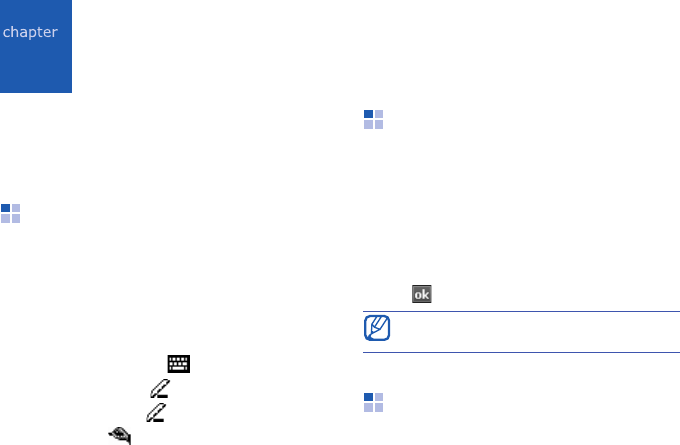
10
1
Enter text
With your device’s touch screen, you can
type or write text and create drawings in
notes, documents, and messages.
Change the text input
method
When you tap a text field, your device will
show an input panel at the bottom of the
screen. You can tap the arrow next to the
input panel icon and choose one of the
following input methods for entering text:
• Onscreen keyboard ( )
•Letter recognizer ( )
• Block recognizer ( )
• Transcriber ( )
You can tap the input panel icon at any time
to show or hide the input panel.
Change the default text
input method
1. From any text field, tap the arrow next to
the input panel icon.
2. Tap
Options...
3. From the
Input Method
tab, choose an
input method.
4. Tap .
Enter text with the
onscreen keyboard
1. Tap the input panel icon.
2. Tap the arrow next to the input panel icon
and select
Keyboard
.
You can also set options for some input
methods.

11
Enter text
3. Tap characters to enter your text.
To switch to numbers and symbols, tap
123
. To access special characters, tap
áü
.
Enter text with Letter
Recognizer
Use the stylus to write individual letters and
numbers on the touch screen.
Make a call from the contact list
1. Tap the input panel icon.
2. Tap the arrow next to the input panel icon
and select
Letter Recognizer
.
3. Write each character in the writing area
at the bottom of the screen:
• Write upper-case letters in the
ABC
column on the left side of the writing
area.
• Write lower-case letters in the
abc
column in the middle of the writing
area.
• Write numbers and symbols in the
123
column on the right side of the writing
area.
To view demonstrations of how to write
characters, tap .
Enter text with Block
Recognizer
Use the stylus to write individual letters and
numbers in text in the Palm Grafitti style.
Make a call from the contact list
1. Tap the input panel icon.
2. Tap the arrow next to the input panel icon
and select
Block Recognizer
.
3. Write each character in the writing area
at the bottom of the screen:
• Write letters on the left side of the
writing area.
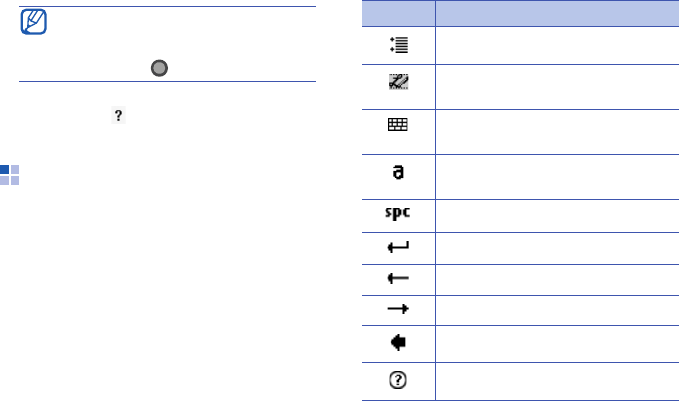
Enter text
12
• Write numbers on the right of the
writing area.
To view demonstrations of how to write
characters, tap .
Enter text with Transcriber
With Transcriber, you can write anywhere on
the screen. Unlike Letter Recognizer or
Block Recognizer, you can use cursive
(joined-up) handwriting to write complete
words.
1. Tap the input panel icon.
2. Tap the arrow next to the input panel icon
and select
Transcriber
.
3. Write legibly anywhere on the screen.
4. Pause and allow Transcriber to convert
your writing to text.
You can access the following tools from the
Transcriber toolbar:
Drag the stylus upward to change case
(
ABC
,
Abc
, or
abc
). Tap once on the
screen to enter symbols (
123
or
abc
will change to ).
Tap To
Change Transcriber options
View demonstrations of how to
write characters
Open the list of punctuation
marks, symbols, and numbers
Change the input mode to
A
,
a
,
or
123
Insert a space
Start a new line
Move the cursor to the left
Move the cursor to the right
Clear your input
Open the Help application

13
Enter text
Create a sketch
With Notes, you can create and capture
sketches.
1. From the Today screen, tap
Start
→
Programs
→
Notes
.
2. Tap
New
.
3. Make a stroke that crosses at least three
ruled lines to start a drawing frame.
Sketches that do not cross three ruled
lines will be treated as writing.
4. Continue your sketch with strokes.
To edit a sketch, tap
Menu
→
Draw
.
Tap and hold the stylus pen on the sketch
until the selection handles appear. You can
then tap and hold the handles to drag or
resize the sketch or tap
Menu
to access
other options.
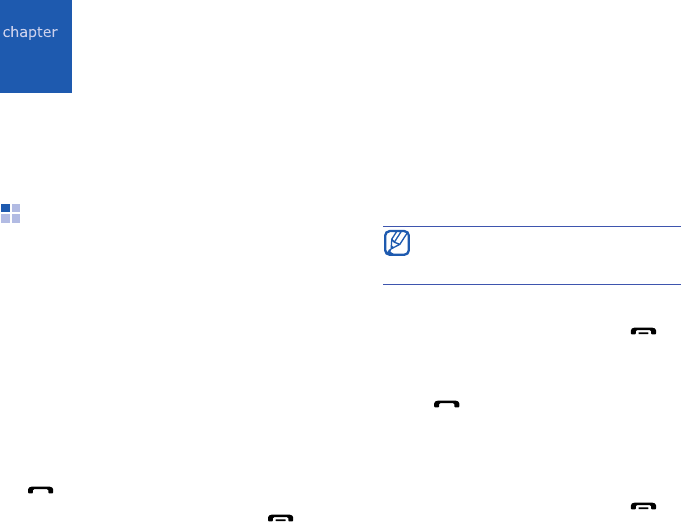
14
2
Communication
Your device allows you to send and receive
many types of calls and messages over
cellular networks and the wireless web.
Calls
Learn to use your device’s call functions. For
basic call functions, see the Quick Start
Guide.
Call an international number
1. Press and hold [
0
] to insert the +
character (this replaces the international
access code).
2. Press the number keys to enter the
complete number you want to dial
(country code, area code, and phone
number), and then tap
Talk
or press
[] to dial.
3. To end the call, tap
End
or press [ ].
Make a call from the contact list
1. From the Today screen, tap
Start
→
Contacts
to open your contact list.
2. Scroll to a contact and tap the contact’s
name.
3. Tap the number you want to dial.
4. To end the call, tap
End
or press [ ].
Make a call from Call History
1. Press [ ].
2. Scroll to a contact and tap the contact’s
name.
3. Tap the number you want to dial.
4. To end the call, tap
End
or press [ ].
To search for a contact, tap the Enter a
name... field and enter a few letters of
the contact’s name.

15
Communication
Forward calls
1. From the Today screen, tap
Start
→
Settings
→
Phone
.
2. From the
Services
tab, tap
Call
Forwarding
→
Get Settings...
3. Tap a forwarding option and enter a
phone number.
4. Tap .
Bar (block) calls
1. From the Today screen, tap
Start
→
Settings
→
Phone
.
2. From the
Services
tab, tap
Call Barring
→
Get Settings...
3. Tap the type of calls you want to bar.
4. Tap .
Messaging
Learn to use messaging functions. For
instructions on entering text, see "Enter
text."
X
p. 10
Send a text message
1. From the Today screen, tap
Start
→
Messaging
→
SMS/MMS
.
2. Tap
Menu
→
New
→
SMS
.
3. Enter a destination number or tap
Menu
→
Add Recipient...
to select a contact.
4. Tap the stylus in the message body.
5. Enter your message text.
6. Tap
Send
to send the message.

Communication
16
Send a multimedia message
1. From the Today screen, tap
Start
→
Messaging
→
SMS/MMS
.
2. Tap
Menu
→
New
→
MMS
.
3. Enter a destination number or tap
Menu
→
Add Recipients
to select a contact.
4. Tap the Subject field and enter a
message subject.
5. Tap the stylus in the message body.
6. Enter your message text.
7. Tap an attachment icon to add a file to
the message:
• : attach a picture
• : attach a music file
• : attach a video
• : capture and attach a photo
• : record and attach a voice memo
8. Tap
Send
to send the message.
Send an email message
1. From the Today screen, tap
Start
→
Messaging
.
2. Tap the name of an email account.
3. Tap
Menu
→
New
.
4. Enter the recipient’s address in the To
field or tap
Menu
→
Add Recipient...
to
select a contact.
5. Tap the subject field and enter a message
subject.
6. Tap the stylus in the message body.
7. Enter your message text.
8. To add an attachment, tap
Menu
→
Insert
→
an attachment type.
9. Tap
Send
to send the message.
The Cc and Bcc fields are located above
the from field.

17
Communication
Retrieve email from a web server
Before you retrieve email messages from an
internet service provider or VPN connection,
you must create an email account.
To retrieve messages from your Outlook
account, see "Synchronise your data."
X
p. 40
1. From the Today screen, tap
Start
→
Messaging
.
2. Tap the name of an email account.
3. Tap
Menu
→
Send/Receive
.
View messages
You can access message folders for all your
messaging accounts (email, SMS, and MMS)
in one location.
To view messages,
1. From the Today screen, tap
Start
’
Messaging
.
2. Tap
SMS/MMS
or the name of an email
account.
The Inbox for the account you selected
will open.
While viewing message folders, you can
switch message folders or accounts by
using the drop-down menu at the top
left of the screen.
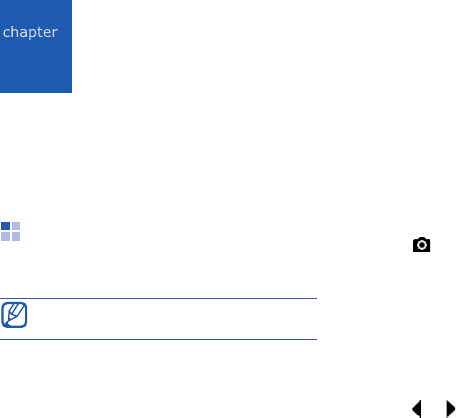
18
3
Media
Learn to use the Camera, Media Album,
Photo Slides, Touch Player, and FM Radio. To
learn about your device’s other media
functions, refer to the Windows Mobile Help.
Camera
Your device allows you to take digital photos
(jpg format) or record videos (3gp format).
Capture a photo
1. Press and hold [Camera].
2. Rotate the device counter-clockwise to
landscape orientation.
3. Aim the lens at the subject and make any
adjustments (see "Adjust Camera
settings").
• Scroll right or left to adjust the
brightness.
• Scroll up or down to zoom.
4. Tap , or press the trackpad or
[Camera] to capture the image.
5. Tap
Save
to save the photo and return to
the viewfinder.
View a photo
1. From the viewfinder, tap
View
.
2. Tap or to view the previous or next
photo.
You cannot launch Mini Player while using
the Camera.
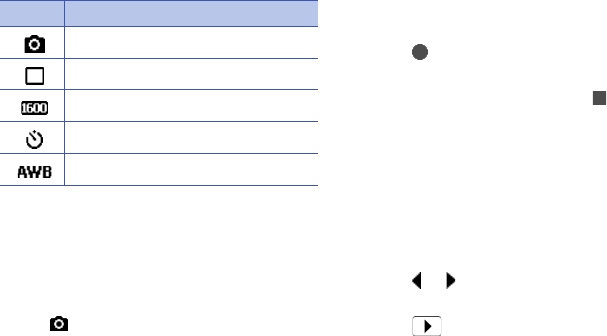
19
Media
Adjust Camera settings
From the viewfinder, tap the screen to show
the following icons. Tap an icon, and then
tap a setting.
Record video
1. Press and hold [Camera].
2. Rotate the device counter-clockwise to
landscape orientation.
3. Tap
→
Camcorder
to launch the
camcorder.
4. Aim the lens at the subject and make any
adjustments (see "Adjust Camcorder
settings").
• Scroll right or left to adjust the
brightness.
• Scroll up or down to zoom.
5. Tap , or press the trackpad or
[Camera] to begin recording.
6. When you have finished, tap , or press
the trackpad or [Camera] to stop
recording.
7. Tap
Save
to save the video and return to
the viewfinder.
Play a video
1. From the viewfinder, tap
View
.
2. Tap or to view the previous or next
video.
3. Tap to play the video.
Icon Function
Mode (switch to camcorder)
Shot mode
Picture size
Timer
White balance
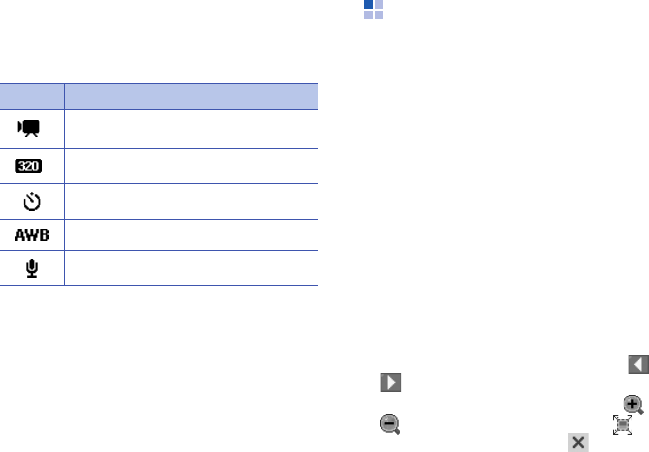
Media
20
Adjust Camcorder settings
From the viewfinder, tap the screen to show
the following icons. Tap an icon, and then
tap a setting.
Media Album
With Media Album, you can view and access
all the files and folders on your device.
View a photo
1. From the Today screen, tap
Start
→
Programs
→
Media Album
.
2. Tap the drop-down menu in the top left of
the screen and select
My Device
.
3. In the list of folders, tap
My Documents
→
My Pictures
.
4. Tap a photo name or thumbnail to open
it.
While viewing photos, you can perform the
following functions:
• To scroll through your photos, tap or
.
• To zoom, tap
Zoom
and then tap or
. To return to full screen, tap . To
exit the zoom screen, tap .
Icon Function
Mode (switch to camera)
Video size
Timer
White balance
Audio
21
Media
• To edit the picture, tap
Menu
→
Edit
Image
.
• To set a photo as a background or caller
ID image, tap
Menu
→
Set as
→
an
option.
• To send a photo, tap
Menu
→
Send
→
a
sending option.
• To print the photo to a Bluetooth printer,
tap
Menu
→
Print via Bluetooth
.
• To view your photos as a slideshow, tap
Menu
→
Play Slide Show
.
Play a video
1. From the Today screen, tap
Start
→
Programs
→
Media Album
.
2. Tap the drop-down menu in the top left of
the screen and select
My Device
.
3. In the list of folders, tap
My Documents
→
My Videos
.
4. Tap a video name or thumbnail to open it.
Open documents
1. From the Today screen, tap
Start
→
Programs
→
Media Album
.
2. Locate and open the folder where the
document is stored.
3. Tap the document name or thumbnail to
open it.
Send a file
1. From the Today screen, tap
Start
→
Programs
→
Media Album
.
2. Locate and open the folder where the file
is stored.
3. Tap
Menu
→
Send
→
an option to send
the file.
• To send as a multimedia message,
select
as Message
X
p. 16
• To send via the Bluetooth wireless
feature, select
via Bluetooth
X
p. 38
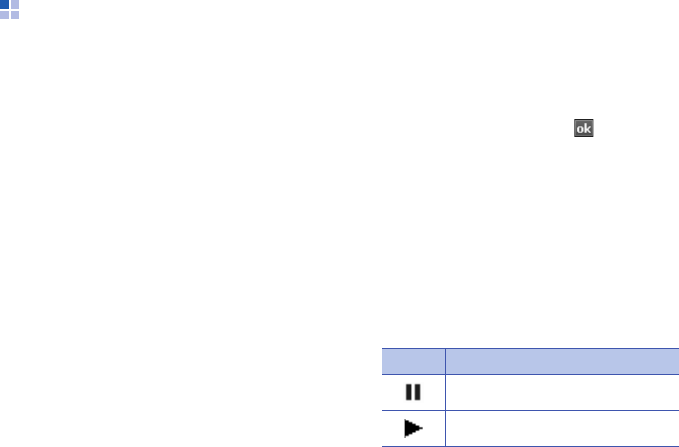
Media
22
Photo Slides
Photo Slides allows you to create photo
albums, edit photos, and view slideshows
with background music.
Create a photo album
1. From the Today screen, tap
Start
→
Programs
→
Photo Slides
.
2. Tap
Menu
→
Create album
.
3. Enter an album name, set the creation
date, and tap
OK
.
4. Locate a photo in another album or folder
and tap
Menu
→
Edit
→
Copy
.
5. Tap the name of your new album or
folder and then tap
Menu
→
Edit
→
Paste
.
Edit photos
1. From the Today screen, tap
Start
→
Programs
→
Photo Slides
.
2. Tap a thumbnail twice to open the photo.
3. Tap
Menu
→
an editing option (
Rotate
Left
,
Rotate Right
,
Crop
,
Effect
).
4. Crop the photo or select an effect option
(if necessary).
5. To save your changes, tap .
View slideshows with
background music
1. From the Today screen, tap
Start
→
Programs
→
Photo Slides
→
a photo
album.
2. Tap
Menu
→
Slide show
.
3. During a slideshow, tap the screen to
display the following controls:
Icon Function
Pause
Play
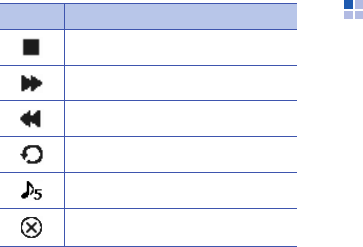
23
Media
You can adjust the volume by dragging your
finger up or down on the trackpad, if the
trackpad function is set to
4-way
Navigation
(from the Today screen, tap
Start
→
Settings
→
the
System
tab
→
Finger Mouse
).
Touch Player
With Touch Player, you can play music and
video files on the device's memory.
Update the library
1. From the Today screen, tap
Start
→
Programs
→
Touch Player
.
2. Tap
Menu
→
Update
.
3. Tap
Search
to update the library.
4. When updating the library is finished, tap
Done
.
Play music or video files
1. From the Today screen, tap
Start
→
Programs
→
Touch Player
.
2. Tap the arrow next to the
All Music
and
select the library you want.
3. Tap a file.
Stop
Skip to the next photo
Skip to the previous photo
Rotate the photo
Change the background music
Quit the slideshow
Icon Function
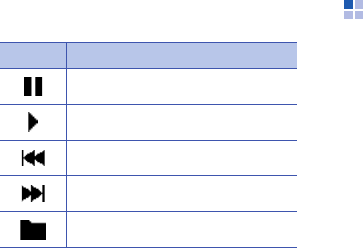
Media
24
4. During playback, use the following
controls:
Create a playlist
1. From the Today screen, tap
Start
→
Programs
→
Touch Player
.
2. Tap
Menu
→
New Play list
.
3. ??
FM Radio
You can listen to your favourite stations with
the FM radio.
Listen to the FM radio
1. Plug a headset into the multifunction
jack.
2. From the Today screen, tap
Start
→
Programs
→
FM Radio
.
3. Scroll left or right to scan through
available radio stations.
4. To adjust the volume level, press the
Volume key.
To switch sound output to the
loudspeaker, tap
Menu
→
Speaker on
.
Icon Function
Pause
Play
Skip to the previous file
Skip to the next file
Return to the file list
25
Media
Set up your favourite radio
station list
Once you have set up a station list, you can
access the stations by scrolling left or right
from the radio screen.
Save radio stations by automatic
tuning
1. From the radio screen, tap
Channels
to
access the station list.
2. Tap
Menu
→
Self-tuning
(this will
replace any existing stations).
3. When you are finished, press
Done
.
Save a radio station manually
1. From the radio screen, scroll to the radio
station you want.
2. Tap
Menu
→
Add to Presets
.
3. Enter a description of the station and tap
Done
.
The station is saved as a preset station.
Select a station
1. From the radio screen, tap
Manual
,
All
,
or
Preset
.
2. Scroll left or right to scan through
available radio stations.

26
4
Personal productivity
Learn to use Contacts, Calendar, Office
Mobile, Notes, Tasks, and Alarms.
Contacts
Learn to use contact cards and groups to
store personal information, such as names,
phone numbers, and addresses.
Create a new Outlook contact
1. From the Today screen, tap
Start
→
Contacts
→
New
→
Outlook Contact
.
2. Enter contact information.
3. When you are finished entering
information, tap to save the contact
card.
Create a new SIM contact
1. From the Today screen, tap
Start
→
Contacts
→
New
→
SIM Contact
.
2. Enter contact information.
3. When you are finished entering
information, tap to save the contact
card.
Search for a contact card
1. From the Today screen, tap
Start
→
Contacts
.
2. Tap the Enter a name... field and enter a
few letter of the contact’s name.
As you enter letters, the screen will show
contacts that match your input.
3. Tap a contact to open it.

27
Personal productivity
Copy or move contact cards
You can copy your contact cards from your
device to your SIM card and vice versa.
When you copy an Outlook contact to your
SIM card, you can only store the contact’s
name and phone number. To retain all the
contact information, synchronise your
Outlook contacts with a PC (see
"Synchronise your data."
X
p. 40).
To copy an Outlook contact to your SIM
card,
1. From the Today screen, tap
Start
→
Contacts
.
2. Tap a contact to open it.
3. Tap
Menu
→
Save to SIM
.
To copy a SIM contact to your device,
1. From the Today screen, tap
Start
→
Contacts
.
2. Tap a contact to open it.
3. Tap
Menu
→
Save to Contacts
.
Assign a speed dial number to a
contact card
1. From the Today screen, tap
Start
→
Contacts
.
2. Tap a contact to open it.
3. Tap
Menu
→
Add to Speed Dial...
4. Tap the up or down arrows next to the
Location field to set a speed dial number.
5. When you are finished, tap .
Assign an image or ringtone to a
contact card
1. From the Today screen, tap
Start
→
Contacts
.
2. Tap a contact to open it.
3. Tap
Menu
→
Edit
.
4. To assign an image, tap the Picture field,
select an image.

Personal productivity
28
5. To assign a ringtone, tap the Ring tone
field and select a ringtone.
6. When you are finished, tap .
Calendar
Use the calendar to keep track of
appointments, birthdays, or other events.
Create a calendar event
1. From the Today screen, tap
Start
→
Calendar
.
2. Tap
Menu
→
New Appointment
.
3. Complete the fields and adjust the
settings for your event.
4. When you are finished, tap .
Change the calendar view
1. From the Today screen, tap
Start
→
Calendar
.
2. Tap
Menu
→
View
→
a view type.
Stop an event alarm
When the alarm sounds for a calendar event
you set previously, tap
Dismiss
.
Office Mobile
With Office Mobile, you can create and edit
Excel workbooks, Word documents, and
OneNote notes or open and view PowerPoint
slideshows. Your device supports files
created with Office 97 and newer versions.
Create and edit an Excel
workbook
1. From the Today screen, tap
Start
→
Office Mobile
→
Excel Mobile
.
2. Tap a cell to select it.
3. Enter values or text with the input panel,
and then tap .
4. Repeat steps 2-3 as necessary.

29
Personal productivity
5. To format cells, tap
Menu
→
Edit
,
Insert
,
Format
, or
Tools
.
6. To save the workbook, tap .
For more details, refer to the online help.
Create and edit a Word
document
1. From the Today screen, tap
Start
→
Office Mobile
→
Word Mobile
.
2. Tap
New
to create a new document (if
necessary).
3. Create your document with the input
panel.
4. To change the font or paragraph format,
tap
Menu
→
Format
→
Font...
or
Paragraph...
5. To save the document, tap .
For more details, refer to the online help.
Open and view a PowerPoint
slideshow
1. From the Today screen, tap
Start
→
Office Mobile
→
PowerPoint Mobile
.
2. Tap the drop-down menu in the top left of
the PowerPoint screen to locate a
PowerPoint file.
3. Tap the file name to launch the
slideshow.
4. To advance the slides, tap the screen.
5. To go back to the previous slide, tap
→
Previous
.
6. To end the slideshow, tap
→
End
Show
.
For more details, refer to the online help.
Create and edit a note
1. From the Today screen, tap
Start
→
Office Mobile
→
OneNote Mobile
.
2. Tap
New
to create a new note.

Personal productivity
30
3. Create your note with the input panel.
4. To change the format, tap
Menu
→
Format
→
a type.
5. To add pictures or voice memos, tap
Menu
→
Take Picture
,
Insert Picture
,
or
Insert Recording
.
6. To save the note, tap
Done
.
For more details, refer to the online help.
Notes
Use Notes to create memos, sketches, and
recordings.
Create a note
1. From the Today screen, tap
Start
→
Programs
→
Notes
.
2. Tap
New
.
3. Create your note.
To create sketches, see "Create a
sketch."
X
p. 13
4. When you are finished, tap .
Send a note
1. From the Today screen, tap
Start
→
Programs
→
Notes
.
2. Tap and hold the name of a note you
want to send.
3. Tap an option to send the file:
• To send as a multimedia message,
select
Send...
X
p. 16
• To send via the Bluetooth wireless
feature, select
Beam File...
X
p. 38
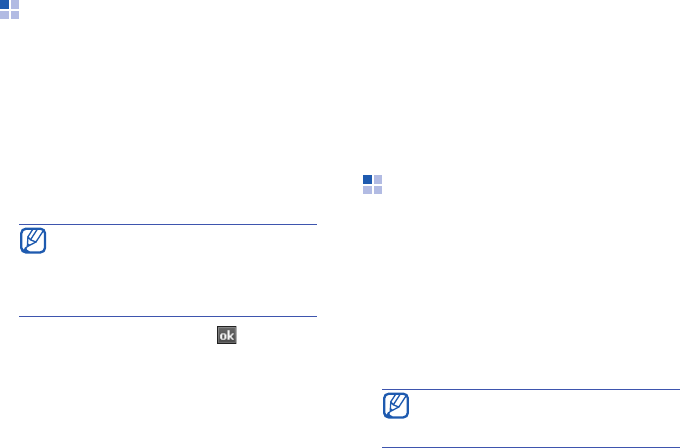
31
Personal productivity
Tasks
With Tasks, you can create to-do lists and
reminders.
Create a task
1. From the Today screen, tap
Start
→
Programs
→
Tasks
.
2. Tap
Menu
→
New Task
.
3. Enter details for the task.
4. When you are finished, tap .
Mark a task as completed
When you have completed a task, return to
the Tasks screen (tap
Start
→
Programs
→
Tasks
) and tap the check box next to the
task name. Once you have marked a task
completed, you will no longer receive any
scheduled reminders for that task.
Alarms
Learn to set and control alarms for
important events.
Set a wake-up alarm
1. From the Today screen, tap
Start
→
Programs
→
Alarms
→
Wake-up
alarm
.
2. Set the wake-up alarm options.
3. When you are finished, tap
Done
.
To set a reminder for the task, tap the
Due field and set a due date. Tap the
Reminder field, select
Remind me
, and
then specify the time and date of the
reminder.
To set a melody for the alarm, tap the
Tone field. To select a time interval to
resume the alarm, tap the Snooze field.
Personal productivity
32
Set an alarm
1. From the Today screen, tap
Start
→
Programs
→
Alarms
.
2. On the alarm list, select one of
Alarm 1
to
Alarm 4
.
To add alarms, tap
Menu
→
Add alarm
.
3. Set each alarm option.
4. When you are finished, tap
Done
.
Stop an alarm
When an alarm sounds, tap
Ok
. When a
wake-up alarm sounds, tap
Dismiss
to stop
it or
Snooze
to stop it with snooze.

33
5
Web
Learn to use Windows Live, Messenger, RSS
Reader, Google Launcher, and Google Maps.
For information about connecting to the
internet and working with Internet Explorer
and Opera Browser, refer to the Help on
your device and the online help.
Windows Live
With Windows Live, you can stay in touch
with friends and access information on the
wireless web quickly.
1. From the Today screen, tap
Start
→
Programs
→
Windows Live
.
2. Tap
Sign in to Windows Live
→
Accept
.
3. Enter your login ID and password and tap
Next
.
4. Follow the onscreen instructions.
Messenger
With Messenger, you can remain available to
other users and stay up-to-date with your
email without a constant connection to the
wireless web. When a new message arrives
or you want to access internet services, the
connection will be restored.
Set up messenger and sign in
1. Sign in to Windows Live (see the previous
section).
2. Scroll left or right to select your login
status and tap
Next
.
3. Follow the onscreen instructions to
complete the setup.

Web
34
Chat with messenger
1. From the Today screen, tap
Start
→
Programs
→
Messenger
.
2. Locate and tap a contact’s name, and
then tap
Send IM
.
3. Enter a message in the text field at the
bottom of the screen, and then tap
Send
.
4. While chatting, you can perform the
following actions:
• Insert emoticons: tap
Menu
→
Add
emoticon
• Invite a contact to chat: tap
Menu
→
Options
→
Add participant
• Transfer a file: tap
Menu
→
Send
→
a
file type
→
a file
• Record and send a voice clip: select
Voice clip
, record your voice clip, and
then tap
Send
• Switch between contact list and chat:
scroll left or right
5. To end the chat, tap
Menu
→
End
conversation
.
RSS Reader
Learn to use RSS reader to get the latest
news and information from your favourite
websites.
To do this, you need to create the
connection first.
Create feeds
1. From the Today screen, tap
Start
→
Programs
→
RSS Reader
.
2. Tap
Menu
→
New Subscription
→
Enter URL
.
3. Enter a web address to subscribe to web
feeds and tap
Add
.
Read latest contents
1. From the Today screen, tap
Start
→
Programs
→
RSS Reader
.
2. Select a feed and tap
Update
to get the
latest contents.
3. Select an updated post.

35
Web
Google Launcher
With Google Launcher, you can use various
Google services, such as the search engine,
G-Mail, Calendar, Google Maps, and
Youtube.
From the Today screen, tap
Start
→
Programs
→
Google Launcher
.
Google Maps
With Google Maps, you can search the
online maps for streets, cities, or countries.
Google Maps also provides you with the
road guides to specified destinations or
allows you to view local business
information, including locations and contact
information.
Search maps
1. From the Today screen, tap
Start
→
Programs
→
Google Maps
.
2. Tap
Accept
when the Terms and
Condition screen appears to load the
online map.
3. Scroll through the map.
• Zoom in: tap
• Zoom out: tap
• Check the current location: tap
Menu
→
My Location
• Change the view mode: tap
Menu
→
Satellite View
• Check the real-time traffic conditions:
tap
Menu
→
Show Traffic
• Connect to an external GPS receiver:
tap
Menu
→
Use GPS
Search for a specific location
1. From the Today screen, tap
Start
→
Programs
→
Google Maps
→
Search
.
2. Enter the address or the category of
the business you want search for and
tap
OK
.
Web
36
3. Tap the balloon to view more results.
4. Tap
Options
to check the direction to
the business or make a call to the
business.
5. Tap
OK
to return to the map.
6. To clear the information on the map,
tap
Menu
→
Clear Map
.
Get directions to a specific
destination
1. From the Today screen, tap
Start
→
Programs
→
Google Maps
→
Menu
→
Directions...
2. Enter the addresses of the starting
location and the ending location.
3. Tap
OK
.
4. Check the driving time and the driving
directions to the destination.
5. Tap
Show
to view on the map.
6. To clear the information on the map,
tap
Menu
→
Clear Map
.
Resetting Google Maps
1. From the Today screen, tap
Start
→
Programs
→
Google Maps
→
Menu
→
Options
→
Reset Google Maps.
2. Tap
Reset
.

37
6
Connectivity
Learn to transfer data to and from your
device via the Bluetooth wireless feature
and synchronise your device to a PC with
ActiveSync. For details on connecting to the
wireless web or a virtual private network
(VPN), refer to the Windows Mobile Help on
your device.
Bluetooth
You can connect with other Bluetooth-
enabled wireless devices over a distance of
10 metres (30 feet). Walls or other
obstacles between devices may block or
impair the wireless connection.
Turn on the Bluetooth wireless
feature
1. From the Today screen, tap
Start
→
Settings
.
2. From the
Connections
tab, tap
Bluetooth
.
3. From the
Mode
tab, tap the check box
next to
Turn on Bluetooth
.
4. To allow other devices to find and
connect to your device, tap the check box
next to
Make this device visible to
other devices
.
5. Tap .
Search for and pair with a
Bluetooth-enabled device
1. From the Today screen, tap
Start
→
Settings
.
2. From the
Connections
tab, tap
Bluetooth
.
3. From the
Devices
tab, tap
Add new
device...
Your device will search for and display
the list of Bluetooth-enabled devices.

Connectivity
38
4. Tap a device name and tap
Next
.
5. Enter the 1- to 16-digit Bluetooth PIN for
the device you are trying to connect to
and tap
Next
.
6. Change the display name for the other
device and select the services you want
(if necessary).
7. Tap
Finish
.
Send data via the Bluetooth
wireless feature
1. Locate an item or file to send.
2. Tap
Menu
→
Send Contact
or
File
→
Beam
, or tap
Menu
→
Beam File...,
Beam Task...
, or
Beam Appointment
.
3. Tap a device from the list.
Receive data via the Bluetooth
wireless feature
1. From the Today screen, tap
Start
→
Settings
.
2. From the
Connections
tab, tap
Beam
.
3. Tap the check box next to
Receive all
incoming beams
.
4. When prompted to allow incoming data,
tap
Yes
.
Set up a Bluetooth COM port
When you have many files to send, you can
establish a Bluetooth COM port.
1. From the Today screen, tap
Start
→
Settings
.
2. From the
Connections
tab, tap
Bluetooth
.
3. From the
COM Ports
tab, tap
New
Outgoing Port
.
4. For outgoing ports, tap the name of a
device, and then tap
Next
.
To pair with another Bluetooth-enabled
device, both devices must use the same
passcode. Headsets or hands-free car kits
may use a fixed passcode, such as
0000
.

39
Connectivity
5. Select a COM port.
6. Tap the check box next to
Secure
Connection
to create a secure
connection between the devices.
7. Tap
Finish
.
Connect to an FTP server
You can connect your device to a file server,
which can be a mobile device or PC, and
exchange files with the server.
1. From the Today screen, tap
Start
→
Programs
→
Bluetooth FTP
.
2. Tap
Yes
.
Tap
Menu
→
Search FTP Servers
(if
necessary).
Your device will search for and display
the list of Bluetooth-enabled devices.
3. Tap an FTP server, and then tap
OK
.
4. Tap
Yes
.
5. Enter the Bluetooth PIN for the server,
and then tap
Next
.
6. Change the display name of the server (if
necessary).
7. Tap
Finish
.
ActiveSync
With ActiveSync, you can synchronise your
device with a PC and back up and restore
your data.
Install ActiveSync on your PC
Before you can synchronise your data, you
must install ActiveSync, either from the
supplied CD-ROM or the Microsoft website
(http://www.microsoft.com).
To install ActiveSync from the supplied CD-
ROM,
1. Insert the CD-ROM into your PC.
2. Follow the onscreen instructions to
complete the setup.

Connectivity
40
3. When installation is complete, follow the
onscreen instructions in the
Synchronisation Setup Wizard to connect
your device to the PC and create a data
sharing partnership.
Connect your device to a PC with
the PC data cable
1. From the Today screen, tap
Start
→
Settings
.
2. From the
Connections
tab, tap
USB
to
PC
.
3. Connect one end of the PC data cable to
the multifunction jack on your device and
the other end to the USB port on your PC.
Synchronise your data
When you connect your device to a PC,
ActiveSync should begin synchronising your
data automatically. You can begin the
synchronisation manually by tapping
Sync
.
To stop a synchronisation in progress, tap
Stop
.
You can also manually find and copy files
from your device to a PC and vice versa—
from the Microsoft ActiveSync window, tap
Explore
.
For more details on synchronising your
data, refer to the ActiveSync Help.
Add an Exchange server
1. From the Today screen, tap
Start
→
Programs
→
ActiveSync
.
2. Tap
Menu
→
Add Server Source...
3. Enter a server address.
4. Tap
Next
.
You can also connect the device to a PC via
the Bluetooth wireless feature. See "Search
for and pair with a Bluetooth-enabled
device."
X
p. 37

41
Connectivity
5. Enter your Exchange user name,
password, and domain name.
6. Tap
Next
.
7. Select the types of data to synchronise.
8. When you are finished, tap
Finish
.
Change the synchronisation
schedule
If you routinely synchronise your data via
an Exchange server, you can configure
settings for both peak and off-peak
schedules.
To change the synchronisation schedules,
1. From the Today screen, tap
Start
→
Programs
→
ActiveSync
.
2. Tap
Menu
→
Schedule...
3. Set the following options:
•
Peak times
: set the frequency of
synchronisations during peak hours
•
Off-peak times
: set the frequency of
synchronisations during off-peak hours
•
Use above settings when roaming
:
set to use the synchronisation
schedules even when roaming
•
Send/receive when I click Send
: set
to synchronise when you click
Send
in
Messaging
4. When you are finished, tap .

42
7
Additional programs
Learn to use Games, Java, Calculator, Smart
Converter, Task Manager, Search, Launcher,
and File Explorer.
Games
Play fun games, such as Bubble Breaker and
Solitaire. You can also download and play
new Java games.
From the Today screen, tap
Start
→
Programs
→
Games
.
Java
Java is a folder where downloaded games
and applications are stored.
From the Today screen, tap
Start
→
Programs
→
Java
.
Calculator
1. From the Today screen, tap
Start
→
Programs
→
Calculator
.
2. Enter the first number using the
calculator buttons on the screen.
To clear the displayed numbers, tap
C
.
To clear the last digit entered in a multi
digit entry, tap the arrow at the right of
the entry box.
3. Tap the math function.
4. Enter the second number.
5. To view the result, tap
=
.
You can use the following buttons on the
screen:
•
C
: clears the number you entered.
•
MC
: clears any value that is stored in the
calculator’s memory.

43
Additional programs
•
MR
: recalls the stored value from
memory and inserts it into the current
calculation.
•
M+
: adds the current number to the
calculator’s memory.
Smart Converter
1. From the Today screen, tap
Start
→
Programs
→
Smart Converter
.
2. Select the type of measurement.
3. Change the base unit in the from field (if
necessary).
4. Enter the base amount.
5. Change the conversion unit in the to field
(if necessary).
The device displays the conversion result.
Task Manager
Your device is a multi-tasking device. It can
run more than one program at the same
time. However, multi-tasking may cause
hang-ups, freezing, memory problems, or
additional power consumption. To avoid
these problems, end unnecessary programs
using
Task Manager
.
1. From the Today screen, tap
Start
→
Programs
→
Task Manager
.
The list of all the programs currently
running on your device appears.
2. To activate a program, tap the program
you want and tap
Menu
→
Switch To
.
To close a program, tap
End Task
. To
close all programs, tap
Menu
→
End All
Tasks
.
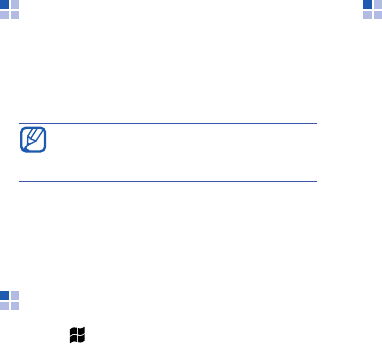
Additional programs
44
Search your device
1. From the Today screen, tap
Start
→
Programs
→
Search
.
2. Enter part of a file or folder name in the
search for field.
3. Tap
Search
.
To open an item in the Results list, tap the
item’s name.
Launcher
1. Press [ ]. You can also tap
Start
→
Programs
→
Launcher
.
2. Select an application.
File Explorer
With File Explorer, you can browse all the
files and folders on your device. From the
Today screen, tap
Start
→
Programs
→
File Explorer
.
To move to a higher-level folder, tap
Up
. Tap
Menu
to rename, delete, or edit your files
and folders.
You can restrict your search by selecting
a data type from the type drop-down
list.

45
8
Troubleshooting
If you have trouble with your device, try
these procedures before you contact a
service professional.
When you try to turn on your device,
the following messages may appear:
Your device does not show a signal
(no bars next to the network icon)
• If you just turned on the device, wait
about 2 minutes for your device to find
the network and receive a signal.
• You may not be able to receive a signal in
tunnels or elevators. Move to an open
area.
• You may be between service areas. You
should receive a signal when you enter a
service area.
Message Try this to solve the problem:
The SIM
card is
missing.
Ensure that the SIM card is
installed correctly.
Enter PIN.
When using the device for the
first time or when the PIN
requirement feature is enabled,
you must enter the PIN supplied
with the SIM card. To disable
the PIN requirement feature,
tap
Start
→
Settings
→
Personal
tab
→
Phone
→
Security
tab, and then clear the
Require PIN when phone is
used
check box.
SIM card
blocked.
Your SIM card is blocked,
usually as a result of entering
your PIN incorrectly several
times. You must enter the PUK
supplied by your service
provider.
Message Try this to solve the problem:

Troubleshooting
46
You forgot a security code, PIN, or
PUK
If you forget or lose this or another code,
contact the seller or your service provider.
Your display shows white lines
The display may show white lines if you
have turned the device on after a long
period of disuse or if you removed the
battery without first turning off the device.
The display should correct itself in a short
time.
You enter a number, but the call is
not dialled
• Ensure that you have pressed [ ].
• Ensure that you have accessed the right
cellular network.
• Ensure that you have not set call barring
for the phone number.
You select a contact to call, but the
call is not dialled
• Ensure that the correct number is stored
in the contact information.
• Re-enter and save the number (if
necessary).
Another caller cannot hear you
speaking
• Ensure that you are not blocking the
built-in microphone.
• Move the built-in microphone closer to
your mouth.
• If using a headset, ensure that it is
properly connected.
The sound quality of a call is poor
• Ensure that you are not blocking the
internal antenna on top of the device.
• When you are in areas with weak signals,
you may lose reception. Move to another
area and try again.
47
Troubleshooting
The battery does not charge properly
or sometimes your device turns itself
off while charging
• Disconnect the device from the charger,
remove and reinstall the battery, and try
charging again.
• The battery terminals may be dirty. Wipe
both gold-coloured contacts with a clean
and soft cloth and try charging the
battery again.
• If the battery no longer charges
completely, dispose of the old battery
properly and replace it with a new
battery.
Your device is hot to the touch
When you use several applications at once,
your device requires more power and may
heat up. This is normal and should not affect
your device’s lifespan or performance.
Your device cannot connect to the
internet
• Ensure that you have entered valid
settings for your internet service provider.
• Ensure that you have activated the
wireless connection to your mobile
service provider and that the signal is not
obstructed.
• Ensure that you have entered the correct
user name and password.
You cannot find a Bluetooth-enabled
device
• Ensure that both devices have activated
the Bluetooth wireless feature.
• Ensure that the distance between the
devices is not more than 10 metres and
that they are not separated by walls or
other obstacles.
• Ensure that the settings for each device
allow them to be visible to other devices.
Troubleshooting
48
• Ensure that both devices are compatible
with Bluetooth wireless technology.
• Ensure that the correct PIN has been
entered on both devices.
You cannot listen to music on a
remote Bluetooth headset
• Ensure that your device is connected to
the headset.
• Ensure that the music format you are
trying to listen to is supported by the
headset.
• Ensure that the distance between the
headset and device is not more than 10
metres and that they are not separated
by walls or other obstacles.

49
9
MICROSOFT SOFTWARE LICENSE TERMS FOR
WINDOWS MOBILE 6 SOFTWARE Agreement
These license terms are an agreement
between you and Samsung Electronics Inc.
("Company"). Please read them. They apply
to the software included on this device. The
software also includes any separate media
on which you received the software.
The software on this device includes
software licensed by Company from
Microsoft Corporation or its affiliate.
The terms also apply to any
• updates,
• supplements,
• Internet-based services, and
• support services
for this software, unless other terms
accompany those items. If so, those terms
apply.
As described below, using some
features also operates as your consent
to the transmission of certain standard
computer information for Internet-
based services.
By using the software, including use on
this device, you accept these terms. If
you do not accept them, do not use the
device or software. Instead, contact
Company to determine its return policy
for a refund or credit.
WARNING:
If the software contains voice
operated technologies, then operating this
software requires user attention. Diverting
attention away from the road while driving
can possibly cause an accident or other
serious consequence. Even occasional, short
diversions of attention can be dangerous if
your attention is diverted away from your
driving task at a critical time. Company and
Microsoft make no representations,
warranties or other determinations that ANY
use of this software is legal, safe, or in any
manner recommended or intended while
driving or otherwise operating a motor
vehicle.
MICROSOFT SOFTWARE LICENSE TERMS FOR WINDOWS MOBILE 6 SOFTWARE Agreement
50
If you comply with these license terms,
you have the rights below.
1. USE RIGHTS.
You may use the software on the device
with which you acquired the software.
2. ADDITIONAL LICENSING
REQUIREMENTS AND/OR USE
RIGHTS.
a.
Specific Use.
Company designed this
device for a specific use. You may
only use the software for that use.
b.
Included Microsoft Programs and
Additional Required Licenses.
Except as provided below, these
license terms apply to all Microsoft
programs included with the software.
If the license terms with any of those
programs give you other rights that
do not expressly conflict with these
license terms, you also have those
rights.
i.This agreement does not grant you
any rights with respect to the
Windows Mobile Device Center,
Microsoft ActiveSync or Microsoft
Outlook 2007 Trial which are subject
to the licenses accompanying those
items.
c.
Speech Recognition.
If the software
includes speech recognition
component(s), you understand that
speech recognition is an inherently
statistical process and that
recognition errors are inherent in the
process. Neither Company nor
Microsoft or their suppliers shall be
liable for any damages arising out of
errors in the speech recognition
process.
51
MICROSOFT SOFTWARE LICENSE TERMS FOR WINDOWS MOBILE 6 SOFTWARE Agreement
d.
Phone Functionality.
If the device
software includes phone functionality,
all or certain portions of the device
software may be inoperable if you do
not have and maintain a service
account with a wireless
telecommunication carrier ("Mobile
Operator"), or if the Mobile Operator's
network is not operating or
configured to operate with the device.
3.
SCOPE OF LICENSE.
The software is
licensed, not sold. This agreement only
gives you some rights to use the
software. Company and Microsoft
reserve all other rights. Unless
applicable law gives you more rights
despite this limitation, you may use the
software only as expressly permitted in
this agreement. In doing so, you must
comply with any technical limitations in
the software that allow you to use it only
in certain ways. You may not:
• work around any technical limitations
in the software;
• reverse engineer, decompile or
disassemble the software;
• make more copies of the software than
specified in this agreement;
• publish the software for others to
copy;
• rent, lease or lend the software; or
• use the software for commercial
software hosting services.
Except as expressly provided in this
agreement, rights to access the software
on this device do not give you any right
to implement Microsoft patents or other
Microsoft intellectual property in
software or devices that access this
device.
You may use remote access technologies
in the software such as Remote Desktop
Mobile to access the software remotely
from a computer or server. You are
responsible for obtaining any licenses
required for use of the protocols to
access other software.

MICROSOFT SOFTWARE LICENSE TERMS FOR WINDOWS MOBILE 6 SOFTWARE Agreement
52
4.
INTERNET-BASED SERVICES.
Microsoft provides Internet-based
services with the software. Microsoft
may change or cancel them at any time.
a.
Consent for Internet-Based
Services.
The software features
described below connect to Microsoft
or service provider computer systems
over the Internet. In some cases, you
will not receive a separate notice
when they connect. You may switch
off some of these features or not use
them. For more information about
these features, visit http://
go.microsoft.com/fwlink/
?LinkId=81931.
By using these features, you
consent to the transmission of this
information.
Microsoft does not use the
information to identify or contact you.
Device Information. The following
features use Internet protocols, which
send to the appropriate systems device
information, such as your Internet
protocol address, the type of operating
system, browser and name and version
of the software you are using, and the
language code of the device where you
installed the software. Microsoft uses
this information to make the Internet-
based services available to you.
•
Windows Mobile Update Feature.
The Windows Mobile Update feature
provides you the ability to obtain and
install software updates on your
device if updates are available. You
may choose not to use this feature.
Company and/or your Mobile
Operator may not support this feature
or an update for your device.
•
Windows Media Digital Rights
Management.
Content owners use
Windows Media digital rights
management technology (WMDRM) to
protect their intellectual property,
including copyrights. This software
and third party software use WMDRM
to play and copy WMDRM-protected
content.
53
MICROSOFT SOFTWARE LICENSE TERMS FOR WINDOWS MOBILE 6 SOFTWARE Agreement
If the software fails to protect the
content, content owners may ask
Microsoft to revoke the software's
ability to use WMDRM to play or copy
protected content. Revocation does
not affect other content. When you
download licenses for protected
content, you agree that Microsoft may
include a revocation list with the
licenses. Content owners may require
you to upgrade WMDRM to access
their content. Microsoft software that
includes WMDRM will ask for your
consent prior to the upgrade. If you
decline an upgrade, you will not be
able to access content that requires
the upgrade.
b.
Misuse of Internet-based
Services.
You may not use these
services in any way that could harm
them or impair anyone else's use of
them. You may not use the services
to try to gain unauthorized access to
any service, data, account or network
by any means.
5.
NOTICES ABOUT THE MPEG-4
VISUAL STANDARD.
The software may
include MPEG-4 visual decoding
technology. This technology is a format
for data compression of video
information. MPEG LA, L.L.C. requires
this notice:
USE OF THIS PRODUCT IN ANY
MANNER THAT COMPLIES WITH THE
MPEG 4 VISUAL STANDARD IS
PROHIBITED, EXCEPT FOR USE
DIRECTLY RELATED TO (A) DATA OR
INFORMATION (i) GENERATED BY
AND OBTAINED WITHOUT CHARGE
FROM A CONSUMER NOT THEREBY
ENGAGED IN A BUSINESS
ENTERPRISE, AND (ii) FOR PERSONAL
USE ONLY; AND (B) OTHER USES
SPECIFICALLY AND SEPARATELY
LICENSED BY MPEG LA, L.L.C.
If you have questions about the
MPEG-4 visual standard, please
contact MPEG LA, L.L.C., 250 Steele
Street, Suite 300, Denver, CO 80206;
www.mpegla.com.
MICROSOFT SOFTWARE LICENSE TERMS FOR WINDOWS MOBILE 6 SOFTWARE Agreement
54
6.
DIGITAL CERTIFICATES.
The software
uses digital certificates in X.509 format.
These digital certificates are used for
authentication.
7.
CONNECTIVITY SOFTWARE.
Your
device package may include Windows
Mobile Device Center or Microsoft
ActiveSync software. If it is included,
then you may install and use it in
accordance with the license terms that
are provided with it. If no license terms
are provided, then you may install and
use only one (1) copy of the software on
a single computer.
8.
NETWORK ACCESS.
If you are using a
network, such as an employer network,
the network administrator may limit
features or functionality on your device.
9.
PRODUCT SUPPORT.
Contact
Company for support options. Refer to
the support number provided with the
device.
10.
LINKS TO THIRD PARTY WEBSITES.
If the software provides links to third
party websites, those links are provided
to you only as a convenience, and the
inclusion of any link does not imply an
endorsement of the third party website
by Microsoft.
11.
BACKUP COPY.
You may make one
backup copy of the software. You may
use it only to reinstall the software on
the device.
12.
PROOF OF LICENSE.
If you acquired
the software on the device, or on a disc
or other media, a genuine Certificate of
Authenticity label with a genuine copy of
the software identifies licensed software.
To be valid, this label must be affixed to
the device, or included on or in
Company's software packaging. If you
receive the label separately, it is not
valid. You should keep the label on the
device or packaging to prove that you
are licensed to use the software. To
identify genuine Microsoft software, see
http://www.howtotell.com.
55
MICROSOFT SOFTWARE LICENSE TERMS FOR WINDOWS MOBILE 6 SOFTWARE Agreement
13.
TRANSFER TO A THIRD PARTY.
You
may transfer the software only with the
device, the Certificate of Authenticity
label, and these license terms directly to
a third party. Before the transfer, that
party must agree that these license
terms apply to the transfer and use of
the software. You may not retain any
copies of the software including the
backup copy.
14.NOT FAULT TOLERANT. The software
is not fault tolerant. Company
installed the software on the device
and is responsible for how it
operates on the device.
15.
RESTRICTED USE.
The Microsoft
software was designed for systems that
do not require fail-safe performance.
You may not use the Microsoft software
in any device or system in which a
malfunction of the software would result
in foreseeable risk of injury or death to
any person. This includes operation of
nuclear facilities, aircraft navigation or
communication systems and air traffic
control.
16.NO WARRANTIES FOR THE
SOFTWARE. The software is
provided "as is". You bear all risks
of using it. Microsoft gives no
express warranties, guarantees or
conditions. Any warranties you
receive regarding the device or the
software do not originate from, and
are not binding on, Microsoft or its
affiliates. When allowed by your
local laws, Company and Microsoft
exclude implied warranties of
merchantability, fitness for a
particular purpose and non-
infringement.
17.LIABILITY LIMITATIONS. You can
recover from Microsoft and its
affiliates only direct damages up to
fifty U.S. Dollars (U.S. $50.00), or
equivalent in local currency. You
cannot recover any other damages,
including consequential, lost profits,
special, indirect or incidental
damages.
MICROSOFT SOFTWARE LICENSE TERMS FOR WINDOWS MOBILE 6 SOFTWARE Agreement
56
This limitation applies to:
• anything related to the software,
services, content (including code)
on third party internet sites, or
third party programs, and
• claims for breach of contract,
breach of warranty, guarantee or
condition, strict liability,
negligence, or other tort to the
extent permitted by applicable
law.
It also applies even if Microsoft
should have been aware of the
possibility of the damages. The
above limitation may not apply to
you because your country may not
allow the exclusion or limitation of
incidental, consequential or other
damages.
18.
EXPORT RESTRICTIONS
. The software
is subject to United States export laws
and regulations. You must comply with
all domestic and international export
laws and regulations that apply to the
software. These laws include restrictions
on destinations, end users and end use.
For additional information, see
www.microsoft.com/exporting.

57
Health and safety information
Exposure to Radio Frequency (RF) Signals
Certification Information (SAR)
Your wireless phone is a radio transmitter
and receiver. It is designed and
manufactured not to exceed the exposure
limits for radio frequency (RF) energy set by
the Federal Communications Commission
(FCC) of the U.S. government. These FCC
exposure limits are derived from the
recommendations of two expert
organizations, the National Counsel on
Radiation Protection and Measurement
(NCRP) and the Institute of Electrical and
Electronics Engineers (IEEE). In both cases,
the recommendations were developed by
scientific and engineering experts drawn
from industry, government, and academia
after extensive reviews of the scientific
literature related to the biological effects of
RF energy. The exposure limit set by the FCC
for wireless mobile phones employs a unit of
measurement known as the Specific
Absorption Rate (SAR).
The SAR is a measure of the rate of
absorption of RF energy by the human body
expressed in units of watts per kilogram (W/
kg). The FCC requires wireless phones to
comply with a safety limit of 1.6 watts per
kilogram (1.6 W/kg). The FCC exposure limit
incorporates a substantial margin of safety
to give additional protection to the public
and to account for any variations in
measurements.
SAR tests are conducted using standard
operating positions accepted by the FCC with
the phone transmitting at its highest
certified power level in all tested frequency
bands. Although the SAR is determined at
the highest certified power level, the actual
SAR level of the phone while operating can
be well below the maximum value. This is
because the phone is designed to operate at
multiple power levels so as to use only the
power required to reach the network. In
general, the closer you are to a wireless
base station antenna, the lower the power
output.
Before a new model phone is available for
sale to the public, it must be tested and
certified to the FCC that it does not exceed

58
the exposure limit established by the FCC.
Tests for each model phone are performed in
positions and locations (e.g. at the ear and
worn on the body) as required by the FCC.
The highest SAR values for this model phone
as reported to the FCC are:
GSM850 Head: 0.334 W/Kg, Body:0.597 W/Kg
GSM1900 Head : 0.391 W/Kg, Body:0.528 W/Kg
For body worn operation, this model phone
has been tested and meets the FCC RF
exposure guidelines whenused with a
Samsung accessory designated for this
product or when used with an accessory that
contains no metal and that positions the
handset a minimum of 1.5 cm from the
body.
Non-compliance with the above restrictions
may result in violation of FCC RF exposure
guidelines. SAR information on this and
other model phones can be viewed on-line at
www.fcc.gov/oet/fccid. This site uses the
phone FCC ID number, A3LSGHI900.
Sometimes it may be necessary to remove
the battery pack to find the number. Once
you have the FCC ID number for a particular
phone, follow the instructions on the website
and it should provide values for typical or
maximum SAR for a particular phone.
Additional product specific SAR information
can also be obtained at www.fcc.gov/cgb/
sar.
Consumer Information on Wireless Phones
The U.S. Food and Drug Administration
(FDA) has published a series of Questions
and Answers for consumers relating to radio
frequency (RF) exposure from wireless
phones. The FDA publication includes the
following information:
What kinds of phones are the subject
of this update?
The term wireless phone refers here to
hand-held wireless phones with built-in
antennas, often called “cell,” “mobile,” or
“PCS” phones. These types of wireless
phones can expose the user to measurable
radio frequency energy (RF) because of the
short distance between the phone and the
user's head. These RF exposures are limited
by Federal Communications Commission
safety guidelines that were developed with
the advice of FDA and other federal health
59
and safety agencies. When the phone is
located at greater distances from the user,
the exposure to RF is drastically lower
because a person's RF exposure decreases
rapidly with increasing distance from the
source. The so-called “cordless phones,”
which have a base unit connected to the
telephone wiring in a house, typically
operate at far lower power levels, and thus
produce RF exposures well within the FCC's
compliance limits.
Do wireless phones pose a health
hazard?
The available scientific evidence does not
show that any health problems are
associated with using wireless phones. There
is no proof, however, that wireless phones
are absolutely safe. Wireless phones emit
low levels of radio frequency energy (RF) in
the microwave range while being used. They
also emit very low levels of RF when in the
stand-by mode. Whereas high levels of RF
can produce health effects (by heating
tissue), exposure to low level RF that does
not produce heating effects causes no
known adverse health effects. Many studies
of low level RF exposures have not found
any biological effects. Some studies have
suggested that some biological effects may
occur, but such findings have not been
confirmed by additional research. In some
cases, other researchers have had difficulty
in reproducing those studies, or in
determining the reasons for inconsistent
results.
What is FDA's role concerning the
safety of wireless phones?
Under the law, FDA does not review the
safety of radiation-emitting consumer
products such as wireless phones before
they can be sold, as it does with new drugs
or medical devices. However, the agency has
authority to take action if wireless phones
are shown to emit radio frequency energy
(RF) at a level that is hazardous to the user.
In such a case, FDA could require the
manufacturers of wireless phones to notify
users of the health hazard and to repair,
replace or recall the phones so that the
hazard no longer exists.
Although the existing scientific data do not
justify FDA regulatory actions, FDA has
60
urged the wireless phone industry to take a
number of steps, including the following:
• “Support needed research into possible
biological effects of RF of the type
emitted by wireless phones;
• “Design wireless phones in a way that
minimizes any RF exposure to the user
that is not necessary for device function;
and
• “Cooperate in providing users of wireless
phones with the best possible
information on possible effects of
wireless phone use on human health.
FDA belongs to an interagency working
group of the federal agencies that have
responsibility for different aspects of RF
safety to ensure coordinated efforts at the
federal level. The following agencies belong
to this working group:
• “National Institute for Occupational
Safety and Health
• “Environmental Protection Agency
• “Federal Communications Commission
• “Occupational Safety and Health
Administration
• “National Telecommunications and
Information Administration
The National Institutes of Health participates
in some interagency working group
activities, as well.
FDA shares regulatory responsibilities for
wireless phones with the Federal
Communications Commission (FCC). All
phones that are sold in the United States
must comply with FCC safety guidelines that
limit RF exposure. FCC relies on FDA and
other health agencies for safety questions
about wireless phones.
FCC also regulates the base stations that the
wireless phone networks rely upon. While
these base stations operate at higher power
than do the wireless phones themselves, the
RF exposures that people get from these
base stations are typically thousands of
times lower than those they can get from
wireless phones. Base stations are thus not
the primary subject of the safety questions
discussed in this document.
What are the results of the research
done already?
61
The research done thus far has produced
conflicting results, and many studies have
suffered from flaws in their research
methods. Animal experiments investigating
the effects of radio frequency energy (RF)
exposures characteristic of wireless phones
have yielded conflicting results that often
cannot be repeated in other laboratories. A
few animal studies, however, have
suggested that low levels of RF could
accelerate the development of cancer in
laboratory animals. However, many of the
studies that showed increased tumor
development used animals that had been
genetically engineered or treated with
cancer-causing chemicals so as to be pre-
disposed to develop cancer in absence of RF
exposure. Other studies exposed the
animals to RF for up to 22 hours per day.
These conditions are not similar to the
conditions under which people use wireless
phones, so we don't know with certainty
what the results of such studies mean for
human health.
Three large epidemiology studies have been
published since December 2000. Between
them, the studies investigated any possible
association between the use of wireless
phones and primary brain cancer, glioma,
meningioma, or acoustic neuroma, tumors
of the brain or salivary gland, leukemia, or
other cancers. None of the studies
demonstrated the existence of any harmful
health effects from wireless phones RF
exposures. However, none of the studies can
answer questions about long-term
exposures, since the average period of
phone use in these studies was around three
years.
What research is needed to decide
whether RF exposure from wireless
phones poses a health risk?
A combination of laboratory studies and
epidemiological studies of people actually
using wireless phones would provide some
of the data that are needed. Lifetime animal
exposure studies could be completed in a
few years. However, very large numbers of
animals would be needed to provide reliable
proof of a cancer promoting effect if one
exists. Epidemiological studies can provide
data that is directly applicable to human
populations, but ten or more years' follow-
62
up may be needed to provide answers about
some health effects, such as cancer. This is
because the interval between the time of
exposure to a cancer-causing agent and the
time tumors develop - if they do - may be
many, many years. The interpretation of
epidemiological studies is hampered by
difficulties in measuring actual RF exposure
during day-to-day use of wireless phones.
Many factors affect this measurement, such
as the angle at which the phone is held, or
which model of phone is used.
What is FDA doing to find out more
about the possible health effects of
wireless phone RF?
FDA is working with the U.S. National
Toxicology Program and with groups of
investigators around the world to ensure
that high priority animal studies are
conducted to address important questions
about the effects of exposure to radio
frequency energy (RF).
FDA has been a leading participant in the
World Health Organization international
Electromagnetic Fields (EMF) Project since
its inception in 1996. An influential result of
this work has been the development of a
detailed agenda of research needs that has
driven the establishment of new research
programs around the world. The Project has
also helped develop a series of public
information documents on EMF issues.
FDA and Cellular Telecommunications &
Internet Association (CTIA) have a formal
Cooperative Research and Development
Agreement (CRADA) to do research on
wireless phone safety. FDA provides the
scientific oversight, obtaining input from
experts in government, industry, and
academic organizations. CTIA-funded
research is conducted through contracts to
independent investigators. The initial
research will include both laboratory studies
and studies of wireless phone users. The
CRADA will also include a broad assessment
of additional research needs in the context
of the latest research developments around
the world.
What steps can I take to reduce my
exposure to radio frequency energy
from my wireless phone?
63
If there is a risk from these products - and
at this point we do not know that there is - it
is probably very small. But if you are
concerned about avoiding even potential
risks, you can take a few simple steps to
minimize your exposure to radio frequency
energy (RF). Since time is a key factor in
how much exposure a person receives,
reducing the amount of time spent using a
wireless phone will reduce RF exposure.
• “If you must conduct extended
conversations by wireless phone every
day, you could place more distance
between your body and the source of the
RF, since the exposure level drops off
dramatically with distance. For example,
you could use a headset and carry the
wireless phone away from your body or
use a wireless phone connected to a
remote antenna.
Again, the scientific data do not demonstrate
that wireless phones are harmful. But if you
are concerned about the RF exposure from
these products, you can use measures like
those described above to reduce your RF
exposure from wireless phone use.
What about children using wireless
phones?
The scientific evidence does not show a
danger to users of wireless phones,
including children and teenagers. If you
want to take steps to lower exposure to
radio frequency energy (RF), the measures
described above would apply to children and
teenagers using wireless phones. Reducing
the time of wireless phone use and
increasing the distance between the user
and the RF source will reduce RF exposure.
Some groups sponsored by other national
governments have advised that children be
discouraged from using wireless phones at
all. For example, the government in the
United Kingdom distributed leaflets
containing such a recommendation in
December 2000. They noted that no
evidence exists that using a wireless phone
causes brain tumors or other ill effects. Their
recommendation to limit wireless phone use
by children was strictly precautionary; it was
not based on scientific evidence that any
health hazard exists.
64
Do hands-free kits for wireless phones
reduce risks from exposure to RF
emissions?
Since there are no known risks from
exposure to RF emissions from wireless
phones, there is no reason to believe that
hands-free kits reduce risks. Hands-free kits
can be used with wireless phones for
convenience and comfort. These systems
reduce the absorption of RF energy in the
head because the phone, which is the source
of the RF emissions, will not be placed
against the head. On the other hand, if the
phone is mounted against the waist or other
part of the body during use, then that part
of the body will absorb more RF energy.
Wireless phones marketed in the U.S. are
required to meet safety requirements
regardless of whether they are used against
the head or against the body. Either
configuration should result in compliance
with the safety limit.
Do wireless phone accessories that
claim to shield the head from RF
radiation work?
Since there are no known risks from
exposure to RF emissions from wireless
phones, there is no reason to believe that
accessories that claim to shield the head
from those emissions reduce risks. Some
products that claim to shield the user from
RF absorption use special phone cases, while
others involve nothing more than a metallic
accessory attached to the phone. Studies
have shown that these products generally do
not work as advertised. Unlike “hand-free”
kits, these so-called “shields” may interfere
with proper operation of the phone. The
phone may be forced to boost its power to
compensate, leading to an increase in RF
absorption. In February 2002, the Federal
trade Commission (FTC) charged two
companies that sold devices that claimed to
protect wireless phone users from radiation
with making false and unsubstantiated
claims. According to FTC, these defendants
lacked a reasonable basis to substantiate
their claim.
What about wireless phone
interference with medical equipment?

65
Radio frequency energy (RF) from wireless
phones can interact with some electronic
devices. For this reason, FDA helped develop
a detailed test method to measure
electromagnetic interference (EMI) of
implanted cardiac pacemakers and
defibrillators from wireless telephones. This
test method is now part of a standard
sponsored by the Association for the
Advancement of Medical instrumentation
(AAMI). The final draft, a joint effort by FDA,
medical device manufacturers, and many
other groups, was completed in late 2000.
This standard will allow manufacturers to
ensure that cardiac pacemakers and
defibrillators are safe from wireless phone
EMI. FDA has tested wireless phones and
helped develop a voluntary standard
sponsored by the Institute of Electrical and
Electronic Engineers (IEEE). This standard
specifies test methods and performance
requirements for hearing aids and wireless
phones so that no interference occurs when
a person uses a compatible phone and a
compatible hearing aid at the same time.
This standard was approved by the IEEE in
2000.
FDA continues to monitor the use of wireless
phones for possible interactions with other
medical devices. Should harmful
interference be found to occur, FDA will
conduct testing to assess the interference
and work to resolve the problem.
Additional information on the safety of RF
exposures from various sources can be
obtained from the following organizations:
• FCC RF Safety Program:
http://www.fcc.gov/oet/rfsafety/
• Environmental Protection Agency (EPA):
http://www.epa.gov/radiation/
• Occupational Safety and Health
Administration's (OSHA):
http://www.osha.gov/SLTC/
radiofrequencyradiation/index.html
• National institute for Occupational Safety
and Health (NIOSH):
http://www.cdc.gov/niosh/emfpg.html
• World health Organization (WHO):
http://www.who.int/peh-emf/

66
• International Commission on Non-
Ionizing Radiation Protection:
http://www.icnirp.de
• National Radiation Protection Board
(UK):
http://www.nrpb.org.uk
• Updated 4/3/2002: US food and Drug
Administration
http://www.fda.gov/cellphones
Road Safety
Your wireless phone gives you the powerful
ability to communicate by voice, almost
anywhere, anytime. But an important
responsibility accompanies the benefits of
wireless phones, one that every user must
uphold.
When driving a car, driving is your first
responsibility. When using your wireless
phone behind the wheel of a car, practice
good common sense and remember the
following tips:
1. Get to know your wireless phone and its
features, such as speed dial and redial. If
available, these features help you to
place your call without taking your
attention off the road.
2. When available, use a hands-free device.
If possible, add an additional layer of
convenience and safety to your wireless
phone with one of the many hands free
accessories available today.
3. Position your wireless phone within easy
reach. Be able to access your wireless
phone without removing your eyes from
the road. If you get an incoming call at
an inconvenient time, let your voice mail
answer it for you.
4. Let the person you are speaking with
know you are driving; if necessary,
suspend the call in heavy traffic or
hazardous weather conditions. Rain,
sleet, snow, ice and even heavy traffic
can be hazardous.
5. Do not take notes or look up phone
numbers while driving. Jotting down a
“to do” list or flipping through your
address book takes attention away from
your primary responsibility, driving
safely.

67
6. Dial sensibly and assess the traffic; if
possible, place calls when you are not
moving or before pulling into traffic. Try
to plan calls when your car will be
stationary. If you need to make a call
while moving, dial only a few numbers,
check the road and your mirrors, then
continue.
7. Do not engage in stressful or emotional
conversations that may be distracting.
Make people you are talking with aware
you are driving and suspend
conversations that have the potential to
divert your attention from the road.
8. Use your wireless phone to call for help.
Dial 9-1-1 or other local emergency
number in the case of fire, traffic
accident or medical emergencies.
Remember, it is a free call on your
wireless phone!
9. Use your wireless phone to help others in
emergencies. If you see an auto
accident, crime in progress or other
serious emergency where lives are in
danger, call 9-1-1 or other local
emergency number, as you would want
others to do for you.
10.Call roadside assistance or a special non-
emergency wireless assistance number
when necessary. If you see a broken-
down vehicle posing no serious hazard, a
broken traffic signal, a minor traffic
accident where no one appears injured,
or a vehicle you know to be stolen, call
roadside assistance or other special non-
emergency number.
“The wireless industry reminds you to
use your phone safely when driving.”
For more information, please call 1-888-
901-SAFE, or visit our web-site www.wow-
com.com
Provided by the Cellular Telecommunications
& Internet Association
Operating Environment
Remember to follow any special regulations
in force in any area and always switch your
phone off whenever it is forbidden to use it,
or when it may cause interference or danger.
When connecting the phone or any

68
accessory to another device, read its user's
guide for detailed safety instructions. Do not
connect incompatible products.
As with other mobile radio transmitting
equipment, users are advised that for the
satisfactory operation of the equipment and
for the safety of personnel, it is
recommended that the equipment should
only be used in the normal operating
position (held to your ear with the antenna
pointing over your shoulder).
Using Your Phone Near Other Electronic
Devices
Most modern electronic equipment is
shielded from radio frequency (RF) signals.
However, certain electronic equipment may
not be shielded against the RF signals from
your wireless phone. Consult the
manufacturer to discuss alternatives.
Pacemakers
Pacemaker manufacturers recommend that
a minimum distance of 15 cm (6 inches) be
maintained between a wireless phone and a
pacemaker to avoid potential interference
with the pacemaker.
These recommendations are consistent with
the independent research and
recommendations of Wireless Technology
Research.
Persons with pacemakers:
• should always keep the phone more than
15 cm (6 inches) from their pacemaker
when the phone is switched on.
• should not carry the phone in a breast
pocket.
• should use the ear opposite the
pacemaker to minimize potential
interference.
If you have any reason to suspect that
interference is taking place, switch your
phone off immediately.
Hearing Aids
Some digital wireless phones may interfere
with some hearing aids. In the event of such
interference, you may wish to consult your
hearing aid manufacturer to discuss
alternatives.

69
Other Medical Devices
If you use any other personal medical
devices, consult the manufacturer of your
device to determine if it is adequately
shielded from external RF energy. Your
physician may be able to assist you in
obtaining this information. Switch your
phone off in health care facilities when any
regulations posted in these areas instruct
you to do so. Hospitals or health care
facilities may be using equipment that could
be sensitive to external RF energy.
Vehicles
RF signals may affect improperly installed or
inadequately shielded electronic systems in
motor vehicles. Check with the
manufacturer or its representative regarding
your vehicle. You should also consult the
manufacturer of any equipment that has
been added to your vehicle.
Posted Facilities
Switch your phone off in any facility where
posted notices require you to do so.
Potentially Explosive Environments
Switch your phone off when in any area with
a potentially explosive atmosphere and obey
all signs and instructions. Sparks in such
areas could cause an explosion or fire
resulting in bodily injury or even death.
Users are advised to switch the phone off
while at a refueling point (service station).
Users are reminded of the need to observe
restrictions on the use of radio equipment in
fuel depots (fuel storage and distribution
areas), chemical plants or where blasting
operations are in progress.
Areas with a potentially explosive
atmosphere are often but not always clearly
marked. They include below deck on boats,
chemical transfer or storage facilities,
vehicles using liquefied petroleum gas (such
as propane or butane), areas where the air
contains chemicals or particles, such as
grain, dust or metal powders, and any other
area where you would normally be advised
to turn off your vehicle engine.

70
Emergency Calls
This phone, like any wireless phone,
operates using radio signals, wireless and
landline networks as well as user
programmed functions, which cannot
guarantee connection in all conditions.
Therefore, you should never rely solely on
any wireless phone for essential
communications (medical emergencies, for
example).
Remember, to make or receive any calls the
phone must be switched on and in a service
area with adequate signal strength.
Emergency calls may not be possible on all
wireless phone networks or when certain
network services and/or phone features are
in use. Check with local service providers.
To make an emergency call:
1. If the phone is not on, switch it on.
2. Key in the emergency number for your
present location (for example, 911 or
other official emergency number).
Emergency numbers vary by location.
3. Press .
If certain features are in use (call barring,
for example), you may first need to
deactivate those features before you can
make an emergency call. Consult this
document and your local cellular service
provider.
When making an emergency call, remember
to give all the necessary information as
accurately as possible. Remember that your
phone may be the only means of
communication at the scene of an accident;
do not cut off the call until given permission
to do so.
Restricting Children's access to your
Phone
Your phone is not a toy. Children should not
be allowed to play with it because they could
hurt themselves and others, damage the
phone or make calls that increase your
phone bill.

71
FCC Notice and Cautions
FCC Notice
The phone may cause TV or radio
interference if used in close proximity to
receiving equipment. The FCC can require
you to stop using the phone if such
interference cannot be eliminated.
• This device complies with Part 15 of
the FCC Rules. Operation is subject to
the following two conditions: (1) this
device may not cause harmful
interference, and (2) this device must
accept any interference received,
including interference that may cause
undesired operation.
• This equipment has been tested and
found to comply with the limits for a
Class B digital device, pursuant to part
15 of the FCC Rules. These limits are
designed to provide reasonable
protection against harmful interference
in a residential installation. This
equipment generates, uses and can
radiate radio frequency energy and,if
not installed and used in accordance
with the instructions, may cause
harmful interference to radio
communications.
However, there is no guarantee that
interference will not occur in a
particular installation. If this equipment
does cause harmful interference to
radio or television reception, which can
be determined by turning the
equipment off and on, the user is
encouraged to try to correct the
interference by one or more of the
following measures:
-Reorient or relocate the receiving
antenna.
-Increase the separation between the
equipment and receiver.
-Connect the equipment into an outlet
on a circuit different from that to which
the receiver is connected.
-Consult the dealer or an experienced
radio/TV technician for help.

72
Vehicles using liquefied petroleum gas (such
as propane or butane) must comply with the
National Fire Protection Standard (NFPA-58).
For a copy of this standard, contact the
National Fire Protection Association, One
Battery march Park, Quincy, MA 02269,
Attn: Publication Sales Division.
Cautions
Changes or modifications made in the radio
phone, not expressly approved by Samsung,
will void the user’s authority to operate the
equipment.
Only use approved batteries, antennas and
chargers. The use of any unauthorized
accessories may be dangerous and void the
phone warranty if said accessories cause
damage or a defect to the phone.
Although your phone is quite sturdy, it is a
complex piece of equipment and can be
broken. Avoid dropping, hitting, bending or
sitting on it.
Other Important Safety Information
• Only qualified personnel should service
the phone or install the phone in a
vehicle. Faulty installation or service may
be dangerous and may invalidate any
warranty applicable to the device.
• Check regularly that all wireless phone
equipment in your vehicle is mounted
and operating properly.
• Do not store or carry flammable liquids,
gases or explosive materials in the same
compartment as the phone, its parts or
accessories.
• For vehicles equipped with an air bag,
remember that an air bag inflates with
great force. Do not place objects,
including both installed or portable
wireless equipment in the area over the
air bag or in the air bag deployment
area. If wireless equipment is improperly
installed and the air bag inflates, serious
injury could result.
• Switch your phone off before boarding an
aircraft. The use of wireless phone in

73
aircraft is illegal and may be dangerous
to the aircraft's operation.
• Failure to observe these instructions may
lead to the suspension or denial of
telephone services to the offender, or
legal action, or both.
Product Performance
Getting the Most Out of Your Signal
Reception
The quality of each call you make or receive
depends on the signal strength in your area.
Your phone informs you of the current signal
strength by displaying a number of bars next
to the signal strength icon. The more bars
displayed, the stronger the signal.
If you're inside a building, being near a
window may give you better reception.
Understanding the Power Save
Feature
If your phone is unable to find a signal after
15 minutes of searching, a Power Save
feature is automatically activated. If your
phone is active, it periodically rechecks
service availability or you can check it
yourself by pressing any key.
Anytime the Power Save feature is activated,
a message displays on the screen. When a
signal is found, your phone returns to
standby mode.
Maintaining Your Phone's Peak
Performance
For the best care of your phone, only
authorized personnel should service your
phone and accessories. Faulty service may
void the warranty.
There are several simple guidelines to
operating your phone properly and
maintaining safe, satisfactory service.
• Hold the phone with the antenna raised,
fully-extended and over your shoulder.
• Try not to hold, bend or twist the phone's
antenna.
• Don't use the phone if the antenna is
damaged.
• Speak directly into the phone's receiver.
• Avoid exposing your phone and
accessories to rain or liquid spills. If your

74
phone does get wet, immediately turn
the power off and remove the battery. If
it is inoperable, call Customer Care for
service.
Availability of Various Features/Ring
Tones
Many services and features are network
dependent and may require additional
subscription and/or usage charges. Not all
features are available for purchase or use in
all areas. Downloadable Ring Tones may be
available at an additional cost. Other
conditions and restrictions may apply. See
your service provider for additional
information.
Battery Standby and Talk Time
Standby and talk times will vary depending
on phone usage patterns and conditions.
Battery power consumption depends on
factors such as network configuration, signal
strength, operating temperature, features
selected, frequency of calls, and voice, data,
and other application usage patterns.
Battery Precautions
• Never use any charger or battery that is
damaged in any way.
• Use the battery only for its intended
purpose.
• If you use the phone near the network's
base station, it uses less power; talk and
standby time are greatly affected by the
signal strength on the cellular network
and the parameters set by the network
operator.
• Battery charging time depends on the
remaining battery charge and the type of
battery and charger used. The battery
can be charged and discharged hundreds
of times, but it will gradually wear out.
When the operation time (talk time and
standby time) is noticeably shorter than
normal, it is time to buy a new battery.
• If left unused, a fully charged battery will
discharge itself over time.
• Use only Samsung-approved batteries
and recharge your battery only with
Samsung-approved chargers. When a
charger is not in use, disconnect it from
the power source. Do not leave the
75
battery connected to a charger for more
than a week, since overcharging may
shorten its life.
• Extreme temperatures will affect the
charging capacity of your battery: it may
require cooling or warming first.
• Do not leave the battery in hot or cold
places, such as in a car in summer or
winter conditions, as you will reduce the
capacity and lifetime of the battery.
Always try to keep the battery at room
temperature. A phone with a hot or cold
battery may temporarily not work, even
when the battery is fully charged. Li-ion
batteries are particularly affected by
temperatures below 0 °C (32 °F).
• Do not short-circuit the battery.
Accidental short- circuiting can occur
when a metallic object (coin, clip or pen)
causes a direct connection between the
+ and - terminals of the battery (metal
strips on the battery), for example when
you carry a spare battery in a pocket or
bag. Short-circuiting the terminals may
damage the battery or the object causing
the short-circuiting.
• Dispose of used batteries in accordance
with local regulations. In some areas, the
disposal of batteries in household or
business trash may be prohibited. For
safe disposal options for Li-Ion batteries,
contact your nearest Samsung
authorized service center. Always
recycle. Do not dispose of batteries in a
fire.

76
Care and Maintenance
Your phone is a product of superior design
and craftsmanship and should be treated
with care. The suggestions below will help
you fulfill any warranty obligations and allow
you to enjoy this product for many years.
• Keep the phone and all its parts and
accessories out of the reach of small
children.
• Keep the phone dry. Precipitation,
humidity and liquids contain minerals
that will corrode electronic circuits.
• Do not use the phone with a wet hand.
Doing so may cause an electric shock to
you or damage to the phone.
• Do not use or store the phone in dusty,
dirty areas, as its moving parts may be
damaged.
• Do not store the phone in hot areas.
High temperatures can shorten the life of
electronic devices, damage batteries,
and warp or melt certain plastics.
• Do not store the phone in cold areas.
When the phone warms up to its normal
operating temperature, moisture can
form inside the phone, which may
damage the phone's electronic circuit
boards.
• Do not drop, knock or shake the phone.
Rough handling can break internal circuit
boards.
• Do not use harsh chemicals, cleaning
solvents or strong detergents to clean
the phone. Wipe it with a soft cloth
slightly dampened in a mild soap-and-
water solution.
• Do not paint the phone. Paint can clog
the device's moving parts and prevent
proper operation.
• Do not put the phone in or on heating
devices, such as a microwave oven, a
stove or a radiator. The phone may
explode when overheated.
• When the phone or battery gets wet, the
label indicating water damage inside the
phone changes color. In this case, phone
repairs are no longer guaranteed by the
manufacturer's warranty, even if the
warranty for your phone has not expired.
77
• If your phone has a flash or light, do not
use it too close to the eyes of people or
animals. This may cause damage to their
eyes.
• Use only the supplied or an approved
replacement antenna. Unauthorized
antennas or modified accessories may
damage the phone and violate
regulations governing radio devices.
• If the phone, battery, charger or any
accessory is not working properly, take it
to your nearest qualified service facility.
The personnel there will assist you, and
if necessary, arrange for service.
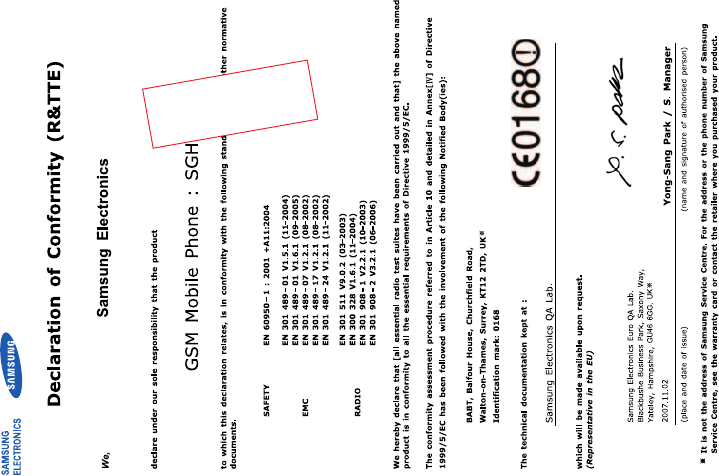
Position Only